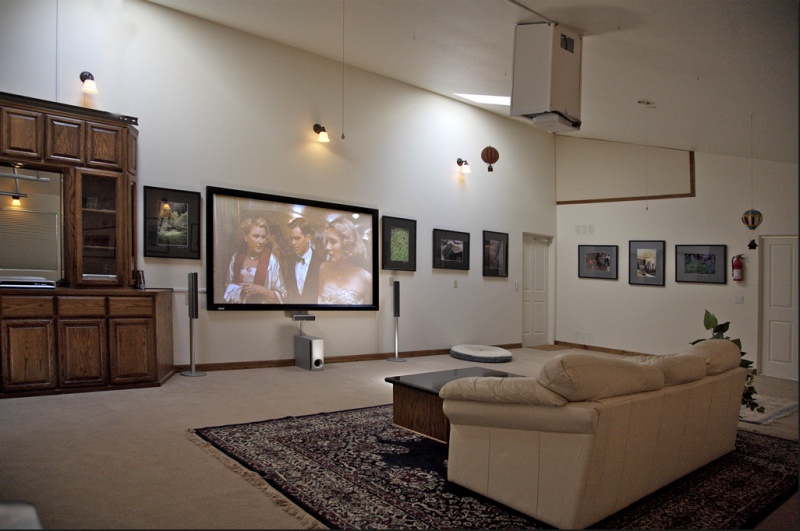35mm film just does not cut it for big prints.

I finally finished framing the last of the fifteen photographs for the walls of the home theater – a converted garage, I should add, lest you think I have hit the jackpot. A large room, some 700 square feet, it offers lots of wall space even after the big screen installation. All of these are 13†x 19†ink jet dye prints made on the fine Espon 1270, with the delays in framing resulting solely from the incompetence of the local art store (Michaels) which stated they could not get me more 22†or 28†frame pieces because it’s a popular size. No kidding. So I finally ordered the remaining ones from Documounts, an estimable business that wanted my money and charged half as much. They also provided all the mats and boards for the pictures and a local glazier cut the glass to fit. All told, a 22†x 28†mounted, matted and framed print, with a nice ebonized ash frame, ran some $60, or one third of the amount charged by the main street framing place.
So there I was last night wondering which movie to watch, while debating the day’s events with that vicious guard dog and breed standard, Bert the Border Terrier, seen above. The goal of the picture project, I reminded Bertram, was that all the snaps must have been taken within the last twelve months. No recycled inventory of past successes. Change or die. And, in the event, every last one of these snaps was taken within a few miles of our home in central coastal California. There are traditional landscapes, strange surreal beach scenes, and the occasional peeling old wall sign. Acting as tour guide for Bertie, whose attention was enhanced by the promise of a cookie, I recited the story of each for him.
By the by, I found myself thinking about the equipment used to take these pictures. First, the realization dawned that almost every last piece of ‘front end’ gear used has now been sold, given the compelling advantages of the full frame sensor in the digital Canon EOS 5D at these print sizes. Second, of the fifteen pictures, eight were taken on medium format, six on large format (4†x 5â€) and just one on 35mm.
Now it wasn’t planned that way. What ended up on the walls had to have visual merit, but it also had to be critically sharp. The reason is that viewers do not respect the rule book that says you should step back when looking at a large photograph. Not a bit of it. The larger the picture, the closer they seem to want to get. Now each of these film originals had been accorded the highest quality processing. The negatives were correctly exposed, film was developed by a great pro lab in Santa Barbara (one of the few that does not play a game of soccer on the beach with your wet negatives) and the originals had been scanned on the highest quality dedicated scanners at 2400 dpi (large format) to 4000 dpi (medium format and 35mm). No grain or dirt reduction software was used to preserve definition. These technologies may be smart, but there’s a trade off. Post processing was done on my iMac G5 whose screen has been colorimetrically (or whatever you call it) balanced using a Monaco EZ Color Optix thingummyjig. You know, the puck you dangle on your screen to measure colors while mumbling incantations to various deities. Bottom line? Color on the screen matches color on the print.
The result is that you cannot tell the large format prints from the medium format ones, but you most certainly can tell the one done on 35mm. Not that there’s anything wrong with the definition in the latter. Using a well calibrated Leica M2 and a 35mm Asph Summicron, that original had, without a doubt, the benefit of the best performing camera/lens combination ever. The Summicron lens is simply breathtaking in its ability to resolve fine detail with great contrast. No, it’s the film that damns the print. You see, if you adopt the ‘stick your nose in the print’ viewing method, the 35mm original clearly shows the film beginning to break up at this print size. There is a hint of grain and, in landscape pictures with much fine filigree detail, that’s a no-no.
Which leads to the inevitable conclusion that for large prints, which are my goal, abandoning 35mm was the right thing to do. Up to 8†x 10â€, decent technique and a top class scanner, meaning a dedicated film scanner not some cheesy flatbed, will get you fine prints from 35mm. Anything larger, forget it. Or, if you like the 35mm format with all its advantages of lens choices and compactness, well, Canon has a digital camera for you. By comparison with 35mm film, the full frame digital prints I have made recently are simply night and day when it comes to resolution and detail, and my technique remains unchanged.

The only way around this issue for ‘35mm film only’ photographers is to make sure you don’t show your work head to head with medium format or full frame digital. If you do, all your protestations about making great big prints from a small negative will be so much dross. If, on the other hand, your goal is display on a computer monitor, well, a Holga will do.
Speaking of which, if you like Holga-sized pictures, you can view the ones in my home theater here.